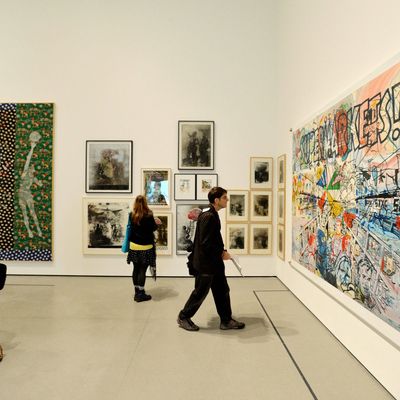
The Museum of Modern Art’s sprawling extravagant “Alibis: Sigmar Polke 1963–2010” is really good. How could it not be, with more than 260 works by a great artist on hand? When Polke died at 69 in 2010, John Baldessari observed that “Any one [Polke] move can provide a career for a lesser artist.” The Whitney curator Chrissie Iles said, “I don’t like using terms like ‘master,’ but Polke is a master; he knows it, and we know it.” I think of him as a Rosetta Stone for young artists, one whose material glee, anarchic inventiveness, and hallucinogenic Blakean imagination puts him in the same influential postwar class with Pollock, Johns, Rauschenberg, Warhol, and his old friend and nemesis Gerhard Richter. He created his own ravishingly visual, impish blends of Pop, Conceptualism, Neo-Dada, Fluxus, Constructivism, and Process Art, all replete with philosophical heft, social bite, and an extraordinary combination of chaos and control.
It’s a godsend to be able to see all this work he made. Yet “Alibis” is that bitter thing: a show of a great artist with great work that fails to be great. Certainly it’s not nearly as large, focused, or well selected as he deserves. Billed as the first Polke survey to contain all of the media he tackled, “Alibis” takes a rapid-fire, cocktail-shaker, look-how-much-he-did, glance-and-move-on approach. At MoMA we’re set upon by a barrage of art, jam-packed into ten galleries on the second floor. It does deliver the mad atmosphere, breakneck industriousness, and frenetic vortices of Polke’s artistic talent and all that it generated. But when you really stand still in “Alibis,” get quiet within yourself, and look around, there are far too few moments when you’re overcome with the sheer strange acidic gorgeousness of his art.
Why? Only a little over a third of what’s on hand is painting, and most of it is hung cheek-by-jowl. I love Polke in all the media that he worked in, but without painting as the clear foundational cornerstone of a major retrospective, his accomplishment is shortchanged, and audiences are denied the art’s full brunt and cosmic beauty. MoMA’s lack of curatorial vision and awkward architecture conspire against visual experience. The show needed more space, even if it meant spilling onto another floor, as the Gerhard Richter and Martin Kippenberger shows did. This season, MoMA gave all of PS1 to Mike Kelley, and a Polke show there would have been tremendous. I suspect that the museum is banking on the art world’s deep admiration for Polke to ensure that there won’t be a negative word written about this show.
The museum is also making gestures toward his kind of anarchy. For example, there are no wall labels*. I eventually adjusted to that, and to relying on the free newsprint guide for details. The uninitiated, however, will find it impossible to follow his development or get any sense of how prescient Polke was throughout his career. Oh, MoMA, your ideas about the language of exhibitions stagger.
Still, as insufficient as “Alibis” is, nobody should skip it. This is Polke we’re talking about, after all. There are sound pieces, videos, a slide show of old illustrations transformed into bleary beings, and films that let us see the tall grinning bespectacled German doing antic things. (His nearsightedness was exacerbated by his close-in hand-painting of hundreds of thousands of “raster dots” — his gritty, undulating answer to Roy Lichtenstein’s regular mechanical Ben-Day dots.) One huge yellowish beauty is coated in what looks like grime floating in syrupy albumen but that turns out to be meteorite granules floating in resin. Painting as stardust made visible. A nearby dazzler has silver leaf and Neolithic tools in an abstract field of synthetic resin. These doozies are modern cave paintings, abstract nebulas. Don’t miss the best-titled painting in recent art history, Higher Beings Commanded: Paint the Upper-Right Corner Black! — a perfect comment on the absurdity of making art, and on the uncanny feeling artists often have that they aren’t doing it entirely on their own.
There are scores of prints, drawings, and works on paper including the 1968 watercolor Polke as Drug — Pulverized Polke in a Glass Pipe, an apt equivalent of what an artist does at work. Nearby is the cartoony Malevich Looks Down on Pollock, a ballpoint-pen sketch of a plain square above a bunch of squiggles on the floor beneath it that offers a wry comment about Polke’s preference for Constructivism over Abstract Expressionism. Polke was among the most innovative photographers ever, and the show includes scores of photos that have been dripped-on, worked-over, cut-up, reprinted, Xeroxed, or otherwise messed with. Near the exhibition’s end are 21 color prints that look like sunbursts on pink grounds. These works were made by exposing the paper to a chunk of uranium that Polke kept in a lead box in his studio. There are weird mechanisms, like Apparatus Whereby One Potato Can Orbit Another, which consists of a wooden stool with a motor that does just what the title says, as if a lost testicle is perpetually circling its mate, trying to create a spark or break away from its gravitational field.
If you want to avoid being bombarded, I recommend standing in front of the wall with three of the Heron paintings from 1968 and 1969. Beautiful birds in arabesque lines with kinetic reeds and lyrical water, salmon-colored outlines and pale-blue hues: They all merge with the grids of patterned fabric that they’re painted on. This is kitsch as exquisiteness, wallpaper as tour de force, a shattering of molds about what is decoratively cliché and what is painterly grace. One of the five mid-’80s paintings of watch towers is done in enamel on bubble wrap, so the image floats free, the stretcher bars show through, and the painting takes on an entirely new material and spiritual presence somewhere between ectoplasmic apparition and UFO or Roman wall painting. Other paintings of towers, which could depict concentration camps or just forest-ranger stations, are rendered in either silver oxide, polymer, dry pigment, silver nitrate, or natural resins, and show us a colorist as melodious as the great Veronese, one who is as pictorially complex as Rubens.
In fact, Polke is in a league with Tintoretto when it comes to being in total control of vast amounts of painterly space. See the gigantic painting Mrs. Autumn and Her Two Daughters, from 1991. It’s painted on translucent synthetic fabric and hangs about a foot off the wall, so it glows with light. The picture merges with its surroundings — as if some optical bridge was being formed between what’s visible and what’s not, the past and the present. Its surface displays a huge painted image of a woman and two young girls cutting up paper, apparently making snow over the landscape. Much of the painting is a massive blast of stark white that becomes a gigantic abstract painting unto itself. Go in close, and you’ll see that the entire painting is inflected with round little fissures where the artist interacted with the paint. Mrs. Autumn has the intensity of an illuminated manuscript and the power of a Gericault’s Raft of the Medusa.
The other place you need to park yourself is in the cattle-chute corridor that contains Velocitas — Firmitudo, a graphite, silver oxide, and damar-resin giant on canvas. This sooty-looking abstract storm utilizes a teeny detail of a Dürer and is as great as its source, and it’s one of the best paintings in the show. As painter Jackie Saccoccio wrote to me, it “has equal amounts of flippant casualness, astute observation, utter devotion to material, and the alchemical stuff that happens in his photos.” Beneath this behemoth (it was originally installed high on the wall, as it is here) lie 14 little abstract paintings. These elemental jewels from the 1980s show Polke the master of accident, control, experimentation, viscosity, resin, varnish, fluorescent paint, and other liquids that metamorphose into incredible textures, unnameable shapes, new biological forms. These little works are the prototypes for tens of thousands of lesser abstract paintings now being cranked out (and sold for vast prices) all over the world.
Which is one reason that every artist needs to see and spend time in this show. Not just to bask in the baffling ecstasies and polymorphous crucible of his art. They need to realize how many young painters now suffer from what I call the Polke Effect, ignorantly or mindlessly repeating his gestures without transforming them into anything remotely original. Perhaps this show will school a few of them, and make them take off their water wings and go into the deep end of art’s ocean, where Polke spent his entire career developing a beautiful, gigantic new Boschian cosmography.
*This sentence has been corrected.




